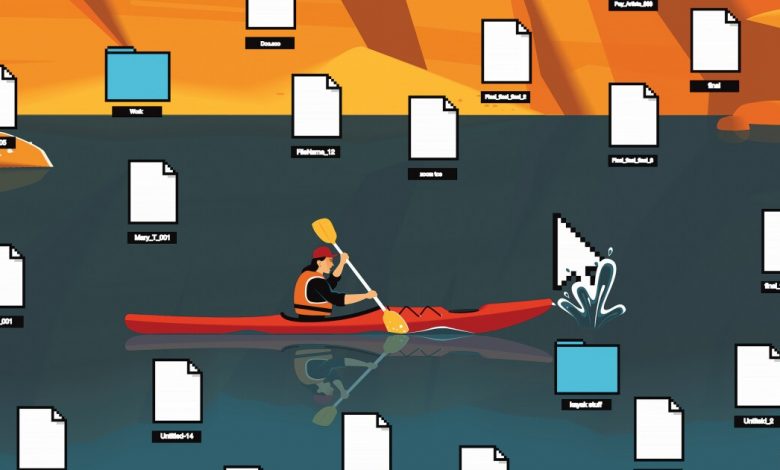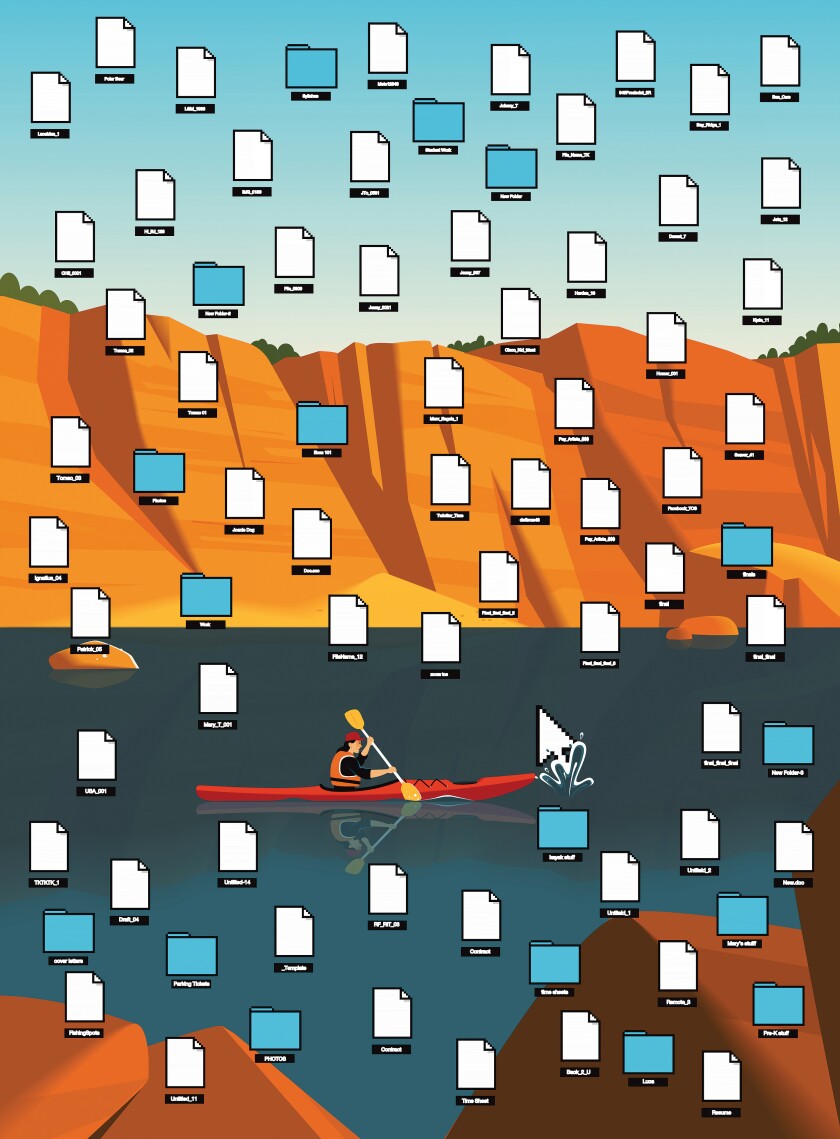The ‘Productivity Poison’ Higher Ed Doesn’t Know It’s Ingesting

[ad_1]
Cal Newport is one of the leading thinkers and writers on these questions. Newport is a computer-science professor at Georgetown University. His books include A World Without Email, Digital Minimalism, and Deep Work. Newport argues in these books that most people and their employers are really bad at prioritizing substantive work over the digital scaffolding that comes with many of our jobs: the emails, the Slack messages, the meeting requests, the Zooms. For many people, that has meant that remote work and burnout have been closely tied together over the last nearly two years.
Newport spoke with The Chronicle‘s Lindsay Ellis as part of the Chronicle Festival that took place in November. Watch a recording of the full interview here. This transcript has been edited for length and clarity.
Lindsay Ellis: Over the summer, I interviewed about 60 people who work in higher ed or who recently left the sector, and I heard from so many of them that they were sick of working in a field in which work-life boundaries were rarely respected. Many of them described feeling severe burnout. Cal, why has work during the pandemic felt so terrible for so many knowledge workers, including those in higher ed?
Cal Newport: When it comes to knowledge work, the way we organize and assign and track and manage is quite haphazard. We tend to just throw things on people’s plates and figure things out on the fly. When we moved to remote during the pandemic, this haphazard approach spiraled out of control. We lost some of the productivity heuristics that we didn’t realize we’d been implementing: being able to grab someone in the hallway for two minutes, or seeing on someone’s face that sense of overload that makes you think twice before emailing them and saying, hey what’re your thoughts on this? Can you jump on a call? Could you work on this report? When we lost those heuristics, things really did spiral. And we got to this Kafkaesque place where we were on Zoom every hour of the day. Where we only talked about work and never had any time to actually do work.
Ellis: Showing that you are working — constantly being on Zoom, responding to emails — can overwhelm the work itself.
Newport: The very fact that this performative approach to work exists underlines a problem that we’ve been facing but not recognizing for a long time: We’re leaving knowledge work too much up to individual employees to manage, and this system is starting to fray. As communication technologies reduce the friction and allow information and obligations to slingshot back and forth faster than ever before, this approach is really starting to show its age.
Ellis: So how can workplaces, whether an academic department like computer science at Georgetown or an HR department at another university, move beyond busyness for busyness’s sake?
Newport: When Peter Drucker coined the term “knowledge work” in the 1950s and played a big role in trying to explain it to the world, there was one point that he really hit on: autonomy. Knowledge workers need autonomy, Drucker argued. You have to leave them alone to figure out how to execute their tasks. That’s an important point, and it was a point that had to be made because it was contrary to how we were thinking about the burgeoning field of management theory at the time.
The mistake we made was to expand the scope of this autonomy from how individuals execute their specific work to how this work is organized. We adopted another idea from Drucker, which was management by objectives. Make it clear what our objectives are, but leave everything else up to the individual, including what they say yes to, what they say no to, how much is on their plates, how they organize what’s on their plates, how they figure out what to work on what days. All of that we leave up to the individual, and that is the foundation of a lot of these problems. We need a more systematic way of thinking about how work is organized, assigned, and tracked.
Ellis: When it comes to a level set between a manager and an employee, could that basically be, what percentage of my week should be focused on X, Y, and Z? Or are you talking bigger picture than that?

John W. Tomac for The Chronicle
Newport: I think that’s important. But what you also really want to do is break down what your team does on a regular basis and then actually sit down as a team and say how you want to implement each of these things. Where does the information come in? Where do we keep it? When and how do we talk about it? This happens on Mondays, this happens on Tuesdays, so there’s no reason to go back and forth on Slack.
Ellis: You’ve argued that one policy that companies should steal from colleges is office hours as a way to cut down on some of the noise. I’m curious why office hours work for faculty, and whether you think they should be expanded more widely within higher ed.
Newport: There are an increasing number of companies that have implemented office hours. The underlying motivation for this is getting around what I call the hyperactive hive-mind mode of collaboration — email was the first, but then others followed, like Slack and Teams. The problem with the hyperactive hive mind is that you now have two or three dozen ongoing, unscheduled, back-and-forth asynchronous conversations that require tending. If I ignored my inbox, there might be seven or eight conversations that grind to a halt that can’t grind to a halt because this meeting has to get set up today, we have to get back to this client in the next hour, etc. So an unintended consequence of this mode of collaboration is that we had to start checking inboxes and instant-messenger tools all the time. Roughly once every six minutes we’re checking an inbox or an instant-messenger tool. This destroys our ability to actually do work with our brains because there is a cost every time you glance at an inbox and see all of those highly salient distractions. So how can we move more interactions away from unscheduled back-and-forth messages?
If that’s the challenge, office hours are a great response. If, like a professor, you have set times on set days that your office door is open, or your Zoom and phone are on. What this allows you to do is defer small back-and-forth conversations out of an inbox and to office hours where they can happen in real time and can happen synchronously.
You might say, oh, this is a pain because now I have to wait, you’re adding more costs into the system. But if the real metric to care about is switching back and forth to that inbox, suddenly that waiting doesn’t seem like a big cost to pay. I can take seven threads that were each going to generate 10 messages. Each of those messages was going to generate 10 inbox checks. That’s 700 context shifts I have just eliminated by saying, “Tuesday and Thursday, 2-3:30, come grab me there.”
Ellis: To make sure I understand, when you shift your brain from working on content to the busy work of setting up a meeting or responding to a Slack message, that takes far more time and effort than one anticipates. To then switch back is yet another shift, and so consolidating all of that to an hour and a half twice a week will allow you more time to focus on the stuff that matters the rest of the time.
Newport: This is the biggest impact on productivity that we don’t even realize is happening. In the early 2000s, we recognized that multitasking is bad. We no longer try to literally do things concurrently, like keep my inbox open while I’m on the phone while I’m writing. We stopped doing that, and we all patted ourselves on the back. But what we didn’t realize was that quick checks of inboxes also have a substantial neurological impact. If you’re quick checking once every six minutes, you’re in a perpetual state of significantly reduced cognitive capacity. And you’re going to get cognitive fatigue, which is why we run out of steam at 2 in the afternoon and give up on doing hard things. It’s productivity poison we didn’t know we were ingesting.
Ellis: If you were inventing an academic department from scratch, what rules would you put in place to set up a healthy work culture to attract the best and brightest?
Newport: I should be careful because I wrote an article for The Chronicle Review a couple years ago on this topic and it ended up with the title, “Is Email Making Professors Stupid?” That earned me a lunch with the dean. One of the things I argued in that article is that the No. 1 resource you have inherent in a professor is the latent cognitive capacity to instruct, mentor, and produce original ideas, and that we should take that resource very seriously.
I had some suggestion in the article, one of which was to be more strict and transparent about service. Not only the amount of service we expect you to do, but also a limit on how much you can do. And we should measure: You do this many hours of service a week, and if you want to do more it has to be signed off on by the dean. No more of this nontransparent system in which one person does 10 times more service than another person because they’re nice or not a jerk and no one really knows what’s going on.
Another thing I argued for is a significant increase in administrative support. We often think that we’re saving money by reducing administrative support because we’re not paying those salaries. But there’s compelling research that shows that if you remove administrative support, that work still has to get done, and now it’s being done by people like professors, who also have to do other work. So they produce less research, and then you need to hire more professors to get the same amount of research produced. And you end up spending more money on salaries anyways.
I recently sort of facetiously said that if you want to start a new university and get the best professors in the world to join the faculty, the only sales pitch you need would be: If you come here, we’re not going to give you an email address. You would have a murderer’s row of Nobel laureates at that school within a few weeks.
Ellis: I’m curious why some companies moved to open offices and why some areas of higher ed are following suit.
Newport: Objectively speaking, it’s a hard to explain phenomenon. There was a rationale that said it’s about more serendipitous encounters, more creative interactions, and therefore teams are going to feel more connected. It’s going to be like Bell Labs. All these innovations will happen. But this is not at all what goes on.
There is a compelling piece of research that measured the interactions of a team right before they move to an open office and then again once they’ve actually moved. What they found is that when this team moved to an open office, interactions went way down. It turns out that in an open office you talk to people less because you don’t want to disturb them.
So why were open offices so pervasive? In Silicon Valley there was a rational reason for them. Those companies were trying to signal to potential hires and investors that they were disruptive. If you’re disruptive, you have a better chance of getting new hires or attracting more capital. That’s a big need if you’re a Silicon Valley start-up. But then it started to spread to other companies. And if you’re not trying to attract 10x coders or your next round of funding from a Sand Hill Road investor, that signaling is less important, so you’re just left with a productivity hit. I’ve never been a fan of open offices.
Ellis: Both from a short-term and a long-term perspective, what is the future of remote work among campus administration and staff?
Newport: It’s a hard future to predict. My working hypothesis is that true remote work, by which I mean you don’t live near a particular geographic region, requires a significant restructuring of how work happens in your organization. If you profile companies that have done remote work successfully, their work is much more structured. They’ve done things to get away from the hyperactive hive mind, to be much more clear about what you’re working on, and how and when we talk about this work. Basically, the more structure in how the work is organized, the easier it is to distribute the participants executing that work.
My prediction is that in the short term — the next year or two — we’re going to see a large-scale retreat more or less back to offices as before, with a more generous approach to one or maybe two days a week you can work from home. It’s not going to be true remote work; it’s going to be more of a hybrid situation. Because if you don’t restructure how work happens, there’s a lot of friction with remote work, and that friction builds up.
My other prediction is that five years from now, we are going to see a significant shift back toward true remote work. The short version of this theory is that during the pandemic, certain sectors, in particular tech start-ups, have begun to figure out these innovations. What changes do you really have to make so that your company can execute with people all over the world, or all over the country? These innovations are going to spread from the sectors where they are now being initiated, and they’re going to spread through the broader economy. And once that knowledge spreads, it’s going to bring in its wake higher profitability because it’s going to give you lower operating costs and higher access to capital because you’re not constrained to a given geographic region.
So it’s going to be an up and down. We’re going to go back toward what we were doing, but five years from now, be it in university administration, large tech companies, or small start-ups, we are going to see a lot more true remote work.
[ad_2]
Source link






